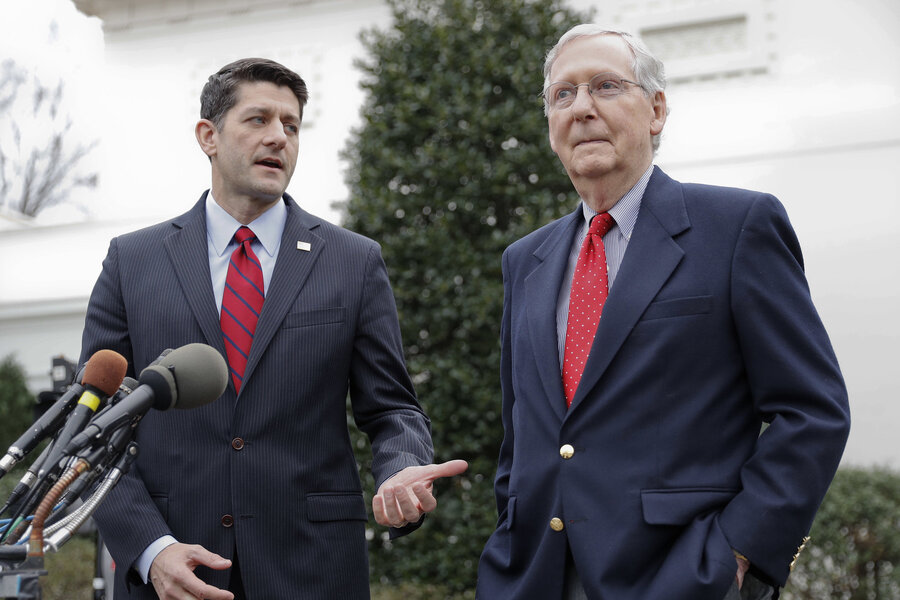Can House's Obamacare replacement survive a divided GOP?
Loading...
| Washington
After seven years of promising to repeal the Affordable Care Act, Republicans are finally at the point of reckoning – unveiling a replacement plan on Monday that upends Obamacare, but will also greatly test President Trump’s ability to unify Republicans behind it.
The plan, put forward by House Republicans, generally follows GOP principles. It effectively repeals much-maligned individual and employer insurance mandates, which Republicans see as interference in personal health-care choices and markets. Instead, it provides tax credits for individuals to purchase their own policies.
It also overhauls Medicaid – federally supported health care for the poor – which many Republicans see as too costly as the federal debt approaches $20 trillion.
But independent analysts say the repeal-and-replace plan, called the American Health Care Act, shows just how difficult it is to have “insurance for everybody” and health-care benefits that “beautifully” cover people, as Mr. Trump puts it, all while reducing costs.
“This is going to be a difficult lift, and I don’t see Trump having much sway in this trek to repeal and replace,” says G. William Hoagland, senior vice president of the Bipartisan Policy Center, in an email. He estimates that 8 million to 12 million fewer people would be covered under the GOP plan. The ACA added coverage for more than 20 million people.
The independent Congressional Budget Office has yet to report on the plan’s costs or its effect on the number of insured, though other independent analysts contacted by the Monitor agree with Mr. Hoagland that fewer people would be covered.
“The House bill is caught in a nasty crossfire” between conservative and moderate Republicans, including GOP governors, writes Lawrence Jacobs, a political science professor and health-care policy expert at the University of Minnesota in Minneapolis, in an email.
A new entitlement?
Conservatives view the plan’s tax credits, which would replace Obamacare’s subsidies, as simply a new “entitlement” program. Moderates, on the other hand, say the tax credits are too meager to help low-income Americans, Professor Jacobs says.
He adds that many of the 16 Republican governors as well as their Democratic colleagues who expanded Medicaid’s reach under Obamacare are also sure to object to reduced outlays under the House plan. Thirty-one states plus the District of Columbia have expanded Medicaid coverage to include more than 11 million people.
The plan would:
• Effectively drop the individual and employer mandates by repealing their penalties immediately – and retroactively to 2016. It would encourage continuous insurance coverage by having insurers impose a 30 percent boost on premiums if consumers let their coverage lapse.
• Replace subsidies that help low-income Americans buy private insurance plans on federal insurance market exchanges with tax credits that could be applied to private plans. The credits, based on age, range from a yearly total of $2,000 to $4,000 for individuals and up to $14,000 for families.
The credits would be applied monthly and are fully refundable, which means they would be paid even if a consumer does not owe taxes (this is why conservatives consider this a new entitlement). The amount of money that patients can save in tax-free Health Savings Accounts would double.
• Fund expansion under Medicaid fully, but only through 2019, after which the funding would decline. In a radical change, all states would get a set amount of money for Medicaid each year based on the size of their state’s Medicaid population. A $100 billion “stability fund” would be available to all states to use however they want to lower health costs.
• Continue the popular parts of Obamacare – allowing young adults to stay on their parents’ health insurance until age 26 and prohibiting denial of coverage for a preexisting condition.
The plan will “drive down costs, encourage competition and give every American access to quality, affordable health insurance,” said House Speaker Paul Ryan (R) of Wisconsin in a statement Monday night.
But Democrats strenuously disagree, even as premiums have dramatically risen and choices declined in many Obamacare insurance markets.
No smooth sailing
So Republicans will have to muscle through the plan on their own, using a budget process known as “reconciliation” that requires only a majority vote for passage in both houses of Congress.
Even that low threshold, however, seems elusive given Republican division over the plan.
“It still looks like Obamacare-lite to me,” budget hawk Sen. Rand Paul (R) of Kentucky told reporters Monday evening. “It’s going to have to be better.” Two other Senate conservatives have voiced similar objections, as well as House conservatives.
But on Monday, four GOP senators from states that expanded Medicaid went in the other direction. They wrote a letter to Senate majority leader Mitch McConnell expressing concern over the House’s Medicaid reform. Given their slim majority, Senate Republicans could afford to lose only two Republicans on repeal-and-replace.
A Republican health-care expert who helped draft part of the ACA says the concerns over changes to Medicaid are well founded.
“This is a dramatic change to the funding of Medicaid” that goes “way beyond” repealing Obamacare, writes Daniel Derksen, director of the Center for Rural Health at the University of Arizona in Tucson, in an email.
The capping and then cutting of Medicaid eligibility and funding over several years shifts the costs and risks from the federal government to states, rural hospitals, physicians, and individuals and their families, writes Dr. Derksen, a physician.
That will make it “much more difficult” for Medicaid enrollees to remain enrolled and receive the care they need, and it will increase the number of charity cases at hospitals, he says.
Passing health-care reform took more than a century, as Presidents Harry Truman, Richard Nixon, and Bill Clinton witnessed, points out Jacobs. It required a filibuster-proof effort of 60 votes in the Senate for President Obama to get there.
“The House bill starts the process,” he writes. “The question is whether it has a future.”






